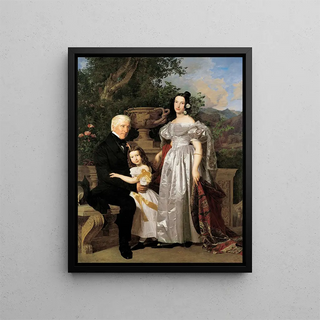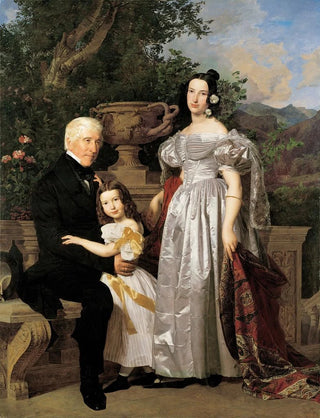Art print The princely advisor of Esterházy Mathias Kerzmann with his second wife Maria Helena née Mikolischtz and his daughter Maria - Ferdinand Georg Waldmüller | Art print


View from behind

Frame (optional)
In the panorama of 19th-century Austrian art, the work of Ferdinand Georg Waldmüller stands out for its ability to capture the very essence of human relationships and everyday moments. The art print Le conseiller princier d'Esterházy Mathias Kerzmann with his second wife Maria Helena née Mikolischtz and his daughter Maria transports us into a universe where family intimacy and social status meet in delicate harmony. This piece, rich in detail and emotion, invites us to explore not only the faces of the depicted characters but also the atmosphere surrounding them, thus revealing a personal and universal story at once.
Style and uniqueness of the work
Waldmüller, master of realism, manages to make every detail come alive in this art print. The expressions on the faces, the subtle gestures of the characters, and the carefully crafted background all testify to meticulous attention to the representation of daily life. This artwork does not merely depict a family scene; it also evokes social tensions and aspirations of its time. The colors, chosen with care, add a dimension of warmth and closeness, creating a strong emotional connection between the viewer and the subjects. Light plays a crucial role in the composition, highlighting the features of the characters while creating a soft and welcoming ambiance. Thus, Waldmüller succeeds in transcending the simple portrait to offer a true visual narrative.
The artist and his influence
Ferdinand Georg Waldmüller is often regarded as one of the pioneers of realism in painting, and his art print has had a major influence on his contemporaries and subsequent generations. Born in 1793 in Vienna, he was able to capture the social upheavals of his time, notably the rise of the bourgeoisie and the transformations of family life. Waldmüller combined refined technique with a keen sensitivity to human emotions, which allowed him to create works that still resonate today. His ability to depict daily life with such psychological depth has inspired many artists, both in Austria and beyond.

Matte finish

View from behind

Frame (optional)
In the panorama of 19th-century Austrian art, the work of Ferdinand Georg Waldmüller stands out for its ability to capture the very essence of human relationships and everyday moments. The art print Le conseiller princier d'Esterházy Mathias Kerzmann with his second wife Maria Helena née Mikolischtz and his daughter Maria transports us into a universe where family intimacy and social status meet in delicate harmony. This piece, rich in detail and emotion, invites us to explore not only the faces of the depicted characters but also the atmosphere surrounding them, thus revealing a personal and universal story at once.
Style and uniqueness of the work
Waldmüller, master of realism, manages to make every detail come alive in this art print. The expressions on the faces, the subtle gestures of the characters, and the carefully crafted background all testify to meticulous attention to the representation of daily life. This artwork does not merely depict a family scene; it also evokes social tensions and aspirations of its time. The colors, chosen with care, add a dimension of warmth and closeness, creating a strong emotional connection between the viewer and the subjects. Light plays a crucial role in the composition, highlighting the features of the characters while creating a soft and welcoming ambiance. Thus, Waldmüller succeeds in transcending the simple portrait to offer a true visual narrative.
The artist and his influence
Ferdinand Georg Waldmüller is often regarded as one of the pioneers of realism in painting, and his art print has had a major influence on his contemporaries and subsequent generations. Born in 1793 in Vienna, he was able to capture the social upheavals of his time, notably the rise of the bourgeoisie and the transformations of family life. Waldmüller combined refined technique with a keen sensitivity to human emotions, which allowed him to create works that still resonate today. His ability to depict daily life with such psychological depth has inspired many artists, both in Austria and beyond.
12,34 €






